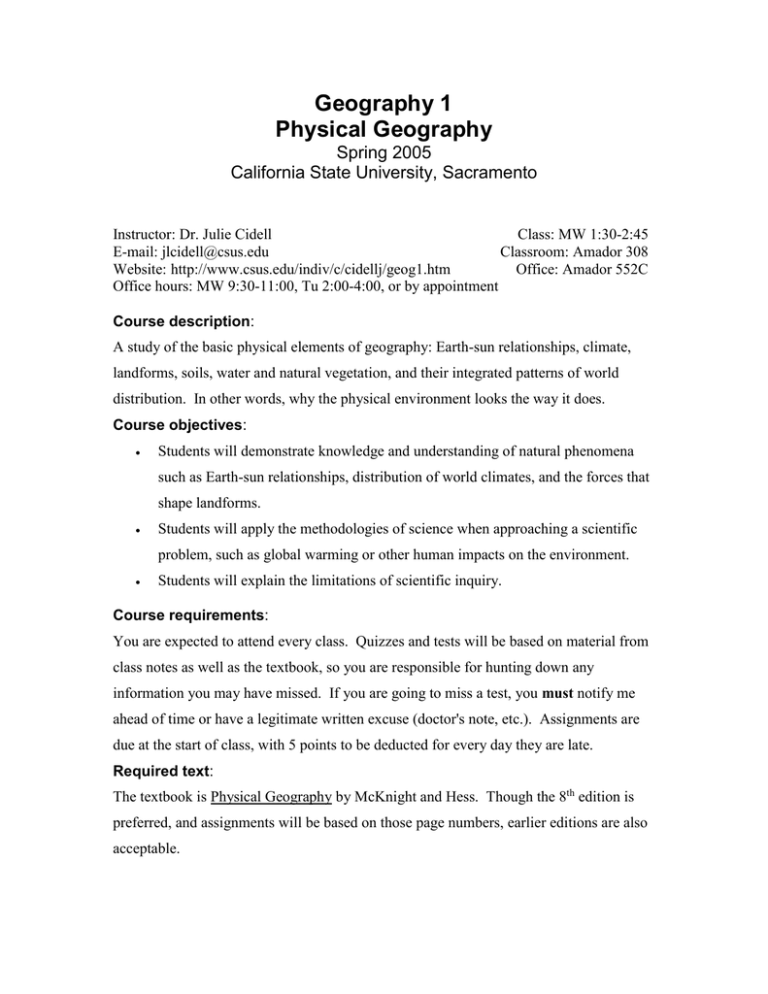Syllabus (Section 4)
advertisement

Geography 1 Physical Geography Spring 2005 California State University, Sacramento Instructor: Dr. Julie Cidell Class: MW 1:30-2:45 E-mail: jlcidell@csus.edu Classroom: Amador 308 Website: http://www.csus.edu/indiv/c/cidellj/geog1.htm Office: Amador 552C Office hours: MW 9:30-11:00, Tu 2:00-4:00, or by appointment Course description: A study of the basic physical elements of geography: Earth-sun relationships, climate, landforms, soils, water and natural vegetation, and their integrated patterns of world distribution. In other words, why the physical environment looks the way it does. Course objectives: Students will demonstrate knowledge and understanding of natural phenomena such as Earth-sun relationships, distribution of world climates, and the forces that shape landforms. Students will apply the methodologies of science when approaching a scientific problem, such as global warming or other human impacts on the environment. Students will explain the limitations of scientific inquiry. Course requirements: You are expected to attend every class. Quizzes and tests will be based on material from class notes as well as the textbook, so you are responsible for hunting down any information you may have missed. If you are going to miss a test, you must notify me ahead of time or have a legitimate written excuse (doctor's note, etc.). Assignments are due at the start of class, with 5 points to be deducted for every day they are late. Required text: The textbook is Physical Geography by McKnight and Hess. Though the 8th edition is preferred, and assignments will be based on those page numbers, earlier editions are also acceptable. Grading: Grading will be based on two midterms and a final, two medium-length written assignments, and a series of "mini-assignments." Tests will include map questions, multiple choice, and short answer questions. Each midterm will cover 5-7 weeks' worth of material, and questions will come from class notes, the textbook, and the additional reading (The Control of Nature). The final will cover the whole semester, but will mainly focus on material from the last third of the class. The writing assignments will be explained as we go along. Spelling and grammar count, so please check them carefully before you hand them in. As always, cheating or plagiarism will result in an F for the assignment and possibly for the entire course. See me if you are unsure about what constitutes cheating or plagiarism. There will be one "mini-assignment" every week, something on the order of answering a question in class based on the textbook, or looking up information at home on a subject we discuss in class. Each of these is worth ten points and can not be made up if missed, although the lowest three will be dropped. Points will be awarded as follows: Assignment Tests Written assignments Mini-assignments Final Total Points 500 (2 tests, 250 points each) 400 (2 parts, 200 points each) 120 points (12 parts, 10 points each) 300 points 1320 Course schedule Date of class Chapter(s) to read Topics covered 1A: Jan. 24 1 Intro to physical geography 1B: Jan. 26 2 Map reading and cartography 2A: Jan. 31 3 The atmosphere 2B: Feb. 2 4 (pp. 70-85) Temperature and insolation 3A: Feb. 7 4 (pp. 85-99) Atmospheric circulation 3B: Feb. 9 5 Winds (global and local) 4A: Feb. 14 6 (pp. 130-149) Atmospheric moisture 4B: Feb. 16 6 (pp. 149-161) Precipitation Assignment 1 due 5A: Feb. 21 7 Weather and storms 5B: Feb. 22 MIDTERM I 6A: Feb. 28 13 Introduction to landforms 6B: Mar. 2 14 (pp. 380-393) Plate tectonics and earthquakes 7A: Mar. 7 14 (pp. 393-423) Volcanoes and diastrophism 7B: Mar. 9 15 Control of Nature: Cooling the Lava Weathering/mass wasting 8A: Mar. 14 18 Arid landscapes 8B: Mar. 16 19 Glacial landscapes SPRING BREAK 9A: Mar. 28 20 Oceans and coastal landscapes 9B: Mar. 30 16 (pp. 444-456) Control of Nature: Atchafalaya Rivers and fluvial landscapes 10A: Apr. 4 16 (pp. 456-471) Rivers and fluvial landscapes 10B: Apr. 6 MIDTERM II 11A: Apr. 11 8 (pp. 198-219) Climate classification: tropical and desert 11B: Apr. 13 8 (pp. 219-239) Climate classification: temperate and tundra 12A: Apr. 18 9 Water and the hydrosphere 12B: Apr. 20 10 Biosphere 13A: Apr. 25 Control of Nature: L.A. Against the Mountains Fire ecology 13B: Apr. 27 12 Soils 14A: May 2 11 (pp. 280-301) Biogeography of plants and animals 14B: May 4 11 (pp. 301-323) Biomes and human modification 15A: May 9 15B: May 11 Natural hazards and disasters Assignment 2 due 4 (pp. 82-85) Global warming/global climate change






